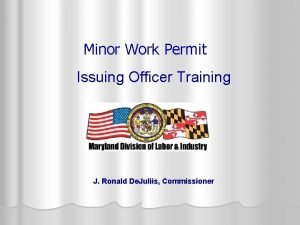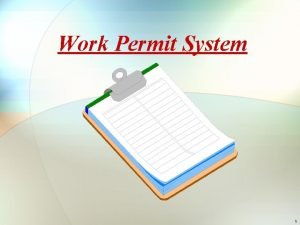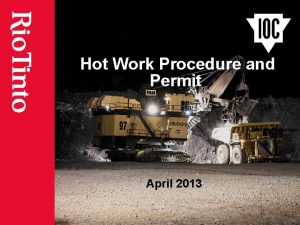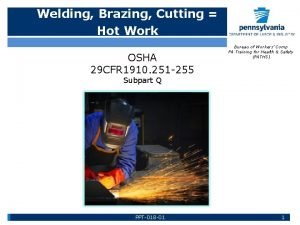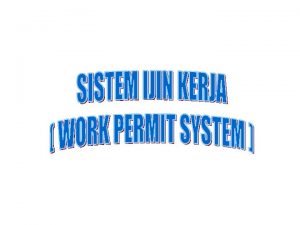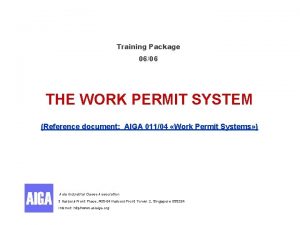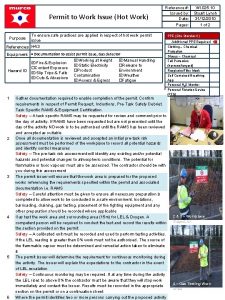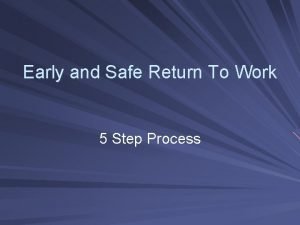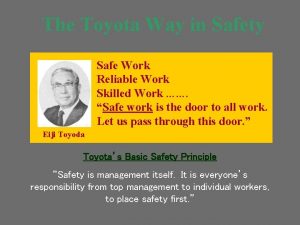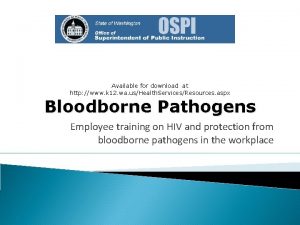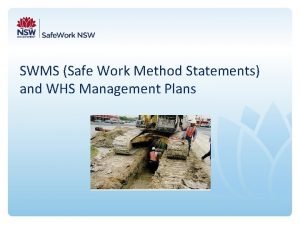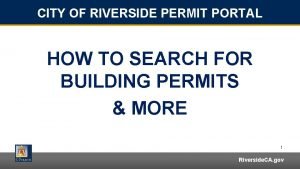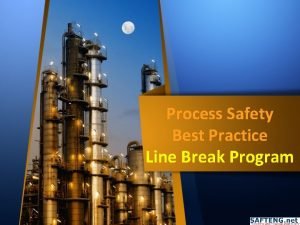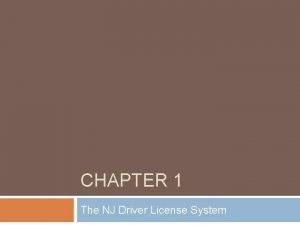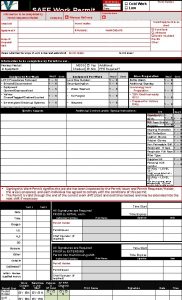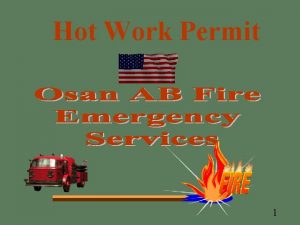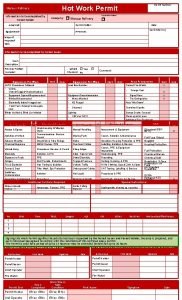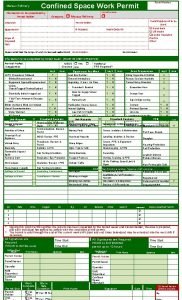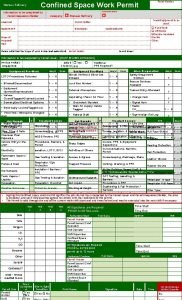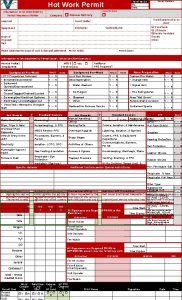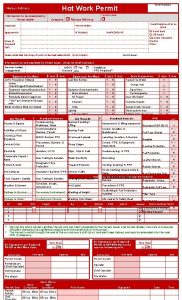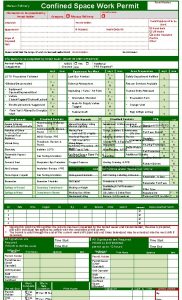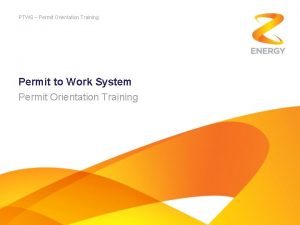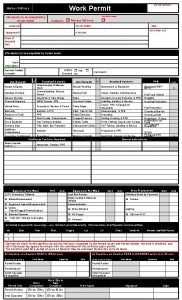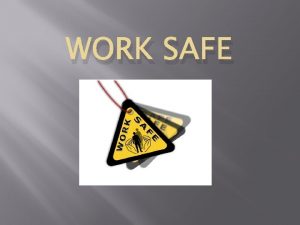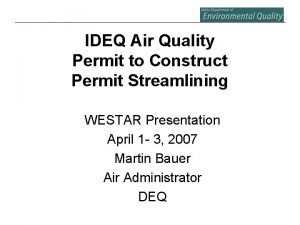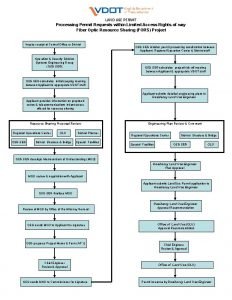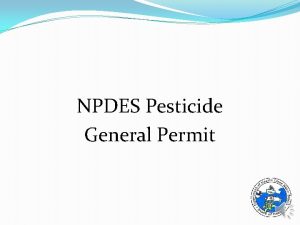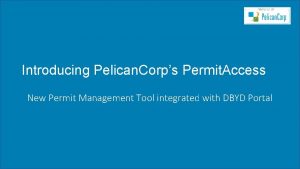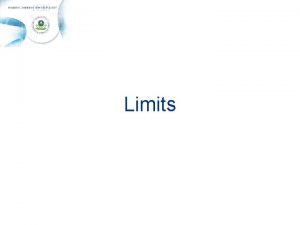What is a safe work permit A safe





















- Slides: 21








What is a safe work permit? A safe work permit is a written record that authorizes specific work, at a specific work location, for a specific time period. Permits are used for controlling and co-ordinating work to establish and maintain safe working conditions. They ensure that all foreseeable hazards have been considered and that the appropriate precautions are defined and carried out in the correct sequence.

The permit is an agreement between the issuer and the receiver that documents the conditions, preparations, precautions, and limitations that need to be clearly understood before work begins. The permit records the steps to be taken to prepare the equipment, building, or area for the work, and the safety precautions, safety equipment, or specific procedures that must be followed to enable the worker(s) to safety complete the work.

Who benefits from a work permit program? � Any industry that has a significant risk because of particular hazards. �Any prime contractor who lets out or sub-contracts work to others to do maintenance or other hazardous work. � Organizations that have individual employees working in isolated areas and performing nonroutine work.

Why use a work permit? All work exposes the worker to some degree of hazard. This degree of hazard determines the type of safeguards required to protect the worker. Most routine work has defined safe work practices or procedures. In the absence of such procedures, safe work permits should be used. Workers engaged in maintenance work may be at risk if the machinery they are working on is started unexpectedly. Such machinery and equipment needs to be isolated by blanking, blinding, or a power lockout system. These procedures can be clearly identified by a work permit system.

Types of safe work permits ØHot work permit ØCold work permit ØConfined space work permit

Hot Work Permit Ø Hot work permits are used when heat or sparks are generated by work such as welding, burning, cutting, riveting, grinding, drilling, and where work involves the use of pneumatic hammers and chippers, nonexplosion proof electrical equipment (lights, tools, and heaters), and internal combustion engines.

Three types of hazardous situations need to be considered when performing hot work: (a) the presence of flammable materials in the equipment; (b) the presence of combustible materials that burn or give off flammable vapours when heated; and (c) the presence of flammable gas in the atmosphere, or gas entering from an adjacent area, such as sewers that have not been properly protected. (Portable detectors for combustible gases can be placed in the area to warn workers of the entry of these gases. )

Cold Work Permit Ø Cold work permits are used in hazardous maintenance work that does not involve “hot work”. Cold work permits are issued when there is no reasonable source of ignition, and when all contact with harmful substances has been eliminated or appropriate precautions taken.

Confined Space Entry Permit ØConfined space entry permits are used when entering any confined space such as a tank, vessel, tower, pit or sewer. The permit should be used in conjunction with a “Code of Practice” which describes all important safety aspects of the operation.

Special Permits Some employers use special permits to cover specific hazards such as: � Ø extremely hazardous conditions; Ø�radioactive materials; Ø �PCBs and other dangerous chemicals; Ø �excavations; Ø�power supplies.

General procedure ØSafe work permits are usually made out in either duplicate or triplicate. When a duplicate system is used, one copy of the permit is retained by the issuer at the work site and the other is held by the worker/department doing the work. ØThe permit should always be available at the work site. The permit is handed back to the issuer at the end of the shift or when the work is completed. In a triplicate permit system, the third copy is used by the safety department to audit the work to see if the requirements of the permit are being met.

Example of a safe work permit checklist A safe work permit is a written record that identifies: (1) the date, time of issue, and time of expiry of the permit; (2) the location of the work —it must be as specific as possible; (3) the department or company doing the work; (4) a description of the work to be done; (5) any toxic, corrosive, flammable, or other dangerous materials in the immediate work area;

(6) whether the work area has been inspected and found free of the above materials; (7) the need for fire protection; (8) the need for isolation — electrical and mechanical hazards locked out and tagged, piping blanked off, tagged, disconnected, drained, or vented; (9) the need for ventilation — air, steam, inert gas purge; (10) the need for testing prior to or during the work for: � harmful substances; � combustible gases; oxygen deficiency; � other hazards e. g. radiation; any specific health hazard — is Material Safety Data Sheet information required? ;

11) the need for specific personal protective equipment to protect the worker from the hazard; (12) the need for specific personal protective equipment to protect the worker from the hazard; (13) the need for emergency procedures and competent rescue personnel; (14) a special instructions and comments section — special procedures, special precautions; (15) a general instruction-to-receiver section; (16) the name and job title of the person who issued the permit and when; (17) the name and job title of the person who received the permit and when; (18) that the work has been completed and the permit signed by the person returning it; and (19) the name of the person signing off the permit and whether or not the work has been completed.
 Maryland work permit
Maryland work permit Responsibility of permit receiver
Responsibility of permit receiver Permit to work procedure
Permit to work procedure Osha hot work
Osha hot work Permit acceptor
Permit acceptor Permit to work procedure
Permit to work procedure Permit to work purpose
Permit to work purpose Safe feed safe food
Safe feed safe food Safe people safe places
Safe people safe places Safe at work
Safe at work Early and safe return to work program
Early and safe return to work program Dojo safety
Dojo safety Clean and safe at work
Clean and safe at work Safe work habits
Safe work habits Whs regulation clause 291
Whs regulation clause 291 Fire permit fee
Fire permit fee Riverside permit search
Riverside permit search Cites permit canada
Cites permit canada Line breaking permit example
Line breaking permit example Examination permit nj restrictions
Examination permit nj restrictions Gdl program
Gdl program Ualbany parking permit
Ualbany parking permit
